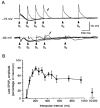Synaptic interactions and inhibitory regulation in auditory cortex
- PMID: 26555718
- PMCID: PMC4808603
- DOI: 10.1016/j.biopsycho.2015.11.001
Synaptic interactions and inhibitory regulation in auditory cortex
Abstract
This Special Issue focuses on the auditory-evoked mismatch negativity (MMN), an electrophysiological index of change, and its reduction in schizophrenia. The following brief review is an attempt to complement the behavioral and clinical contributions to the Special Issue by providing basic information on synaptic interactions and processing in auditory cortex. A key observation in previous studies is that the MMN involves activation of cortical N-methyl-D-aspartate (NMDA) receptors. Yet, NMDA receptor activation is regulated by a number of synaptic events, which also may contribute to the MMN reduction in schizophrenia. Accordingly, this review will focus on synaptic interactions, notably inhibitory regulation of NMDA receptor-mediated activity, in auditory cortex.
Keywords: Auditory cortex; GABA; Glutamate; Mismatch negativity; NMDA; Neuromodulation; Nicotinic acetylcholine receptor; Synaptic integration; Thalamocortical.
Copyright © 2015 Elsevier B.V. All rights reserved.
Figures



Similar articles
-
A predictive coding account of MMN reduction in schizophrenia.Biol Psychol. 2016 Apr;116:68-74. doi: 10.1016/j.biopsycho.2015.10.011. Epub 2015 Nov 12. Biol Psychol. 2016. PMID: 26582536
-
Role of cortical N-methyl-D-aspartate receptors in auditory sensory memory and mismatch negativity generation: implications for schizophrenia.Proc Natl Acad Sci U S A. 1996 Oct 15;93(21):11962-7. doi: 10.1073/pnas.93.21.11962. Proc Natl Acad Sci U S A. 1996. PMID: 8876245 Free PMC article.
-
Synaptic interactions involving acetylcholine, glutamate, and GABA in rat auditory cortex.Exp Brain Res. 1995;107(1):59-72. doi: 10.1007/BF00228017. Exp Brain Res. 1995. PMID: 8751063
-
Intracortical mechanisms of mismatch negativity dysfunction in schizophrenia.Audiol Neurootol. 2000 May-Aug;5(3-4):207-15. doi: 10.1159/000013882. Audiol Neurootol. 2000. PMID: 10859415 Review.
-
Mismatch negativity as a biomarker of theta band oscillatory dysfunction in schizophrenia.Schizophr Res. 2018 Jan;191:51-60. doi: 10.1016/j.schres.2017.06.023. Epub 2017 Jun 28. Schizophr Res. 2018. PMID: 28666633 Review.
Cited by
-
CDP-choline and galantamine, a personalized α7 nicotinic acetylcholine receptor targeted treatment for the modulation of speech MMN indexed deviance detection in healthy volunteers: a pilot study.Psychopharmacology (Berl). 2020 Dec;237(12):3665-3687. doi: 10.1007/s00213-020-05646-1. Epub 2020 Aug 27. Psychopharmacology (Berl). 2020. PMID: 32851421 Clinical Trial.
-
Predicting antidepressant responsiveness in major depressive disorder patients via electroencephalography gamma-band dynamic functional connectivity in response to salient auditory stimuli.Int J Neuropsychopharmacol. 2025 Jul 23;28(7):pyaf042. doi: 10.1093/ijnp/pyaf042. Int J Neuropsychopharmacol. 2025. PMID: 40577659 Free PMC article.
-
Context-Dependent Inhibitory Control of Stimulus-Specific Adaptation.J Neurosci. 2022 Jun 8;42(23):4629-4651. doi: 10.1523/JNEUROSCI.0988-21.2022. Epub 2022 Apr 27. J Neurosci. 2022. PMID: 35477904 Free PMC article.
-
Modulation of Auditory Novelty Processing by Dexmedetomidine and Natural Sleep: A Human Intracranial Electrophysiology Study.Eur J Neurosci. 2025 Jul;62(1):e70181. doi: 10.1111/ejn.70181. Eur J Neurosci. 2025. PMID: 40653365 Free PMC article.
-
An α7 nAChR approach for the baseline-dependent modulation of deviance detection in schizophrenia: A pilot study assessing the combined effect of CDP-choline and galantamine.J Psychopharmacol. 2023 Apr;37(4):381-395. doi: 10.1177/02698811231158903. Epub 2023 Mar 16. J Psychopharmacol. 2023. PMID: 36927273 Free PMC article. Clinical Trial.
References
-
- Ayala YA, Perez-Gonzalez D, Malmierca M. Stimulus-specific adaptation in the inferior colliculus: The role of excitatory, inhibitory and modulatory inputs. Biological Psychololgy. 2015 this volume. - PubMed
-
- Broide RS, Leslie FM. The alpha7 nicotinic acetylcholine receptor in neuronal plasticity. Mol Neurobiol. 1999;20(1):1–16. - PubMed
-
- Brosch M, Schreiner CE. Time course of forward masking tuning curves in cat primary auditory cortex. J Neurophysiol. 1997;77(2):923–943. - PubMed
-
- Calford MB, Semple MN. Monaural inhibition in cat auditory cortex. J Neurophysiol. 1995;73(5):1876–1891. - PubMed
Publication types
MeSH terms
Substances
Grants and funding
LinkOut - more resources
Full Text Sources
Other Literature Sources

